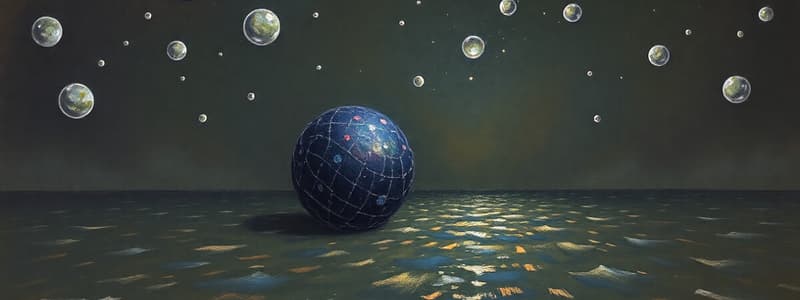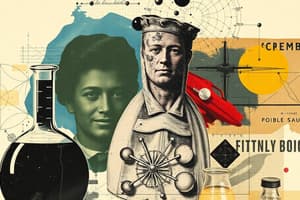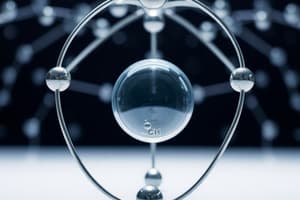Podcast
Questions and Answers
What determines the atomic number of an element?
What determines the atomic number of an element?
- Mass of the atom
- Number of protons (correct)
- Number of electrons
- Number of neutrons
Covalent bonds involve the transfer of electrons between atoms.
Covalent bonds involve the transfer of electrons between atoms.
False (B)
What is the significance of the octet rule in chemical bonding?
What is the significance of the octet rule in chemical bonding?
Atoms strive to have a full outer electron shell, promoting stability.
The __________ organizes elements based on atomic number and properties.
The __________ organizes elements based on atomic number and properties.
Match the type of bond with its description:
Match the type of bond with its description:
Which of the following statements is true regarding isotopes?
Which of the following statements is true regarding isotopes?
Van der Waals forces are stronger than covalent bonds.
Van der Waals forces are stronger than covalent bonds.
Name a field where chemistry plays a crucial role.
Name a field where chemistry plays a crucial role.
Which of the following correctly describes reactants?
Which of the following correctly describes reactants?
A liquid has a fixed shape and volume.
A liquid has a fixed shape and volume.
What is the role of the solute in a solution?
What is the role of the solute in a solution?
Acids produce ______ ions when dissolved in water.
Acids produce ______ ions when dissolved in water.
Match the states of matter with their characteristics:
Match the states of matter with their characteristics:
What is the first law of thermodynamics?
What is the first law of thermodynamics?
In nuclear chemistry, beta decay involves the release of alpha particles.
In nuclear chemistry, beta decay involves the release of alpha particles.
When acids and bases react, they undergo a ______ reaction to form water and a salt.
When acids and bases react, they undergo a ______ reaction to form water and a salt.
Flashcards
What is chemistry?
What is chemistry?
The study of matter and its properties, including its composition, behavior, and the changes it undergoes.
What is an atom?
What is an atom?
The smallest unit of an element that can exist, composed of a nucleus containing protons and neutrons, with electrons orbiting the nucleus in energy levels.
What is atomic number?
What is atomic number?
The number of protons in an atom's nucleus, which determines the element's identity.
What are isotopes?
What are isotopes?
Signup and view all the flashcards
What are chemical bonds?
What are chemical bonds?
Signup and view all the flashcards
What is a covalent bond?
What is a covalent bond?
Signup and view all the flashcards
What is a chemical reaction?
What is a chemical reaction?
Signup and view all the flashcards
What is the periodic table?
What is the periodic table?
Signup and view all the flashcards
Reactant
Reactant
Signup and view all the flashcards
Product
Product
Signup and view all the flashcards
Chemical equation
Chemical equation
Signup and view all the flashcards
Balancing chemical equations
Balancing chemical equations
Signup and view all the flashcards
Synthesis reaction
Synthesis reaction
Signup and view all the flashcards
Decomposition reaction
Decomposition reaction
Signup and view all the flashcards
Single replacement reaction
Single replacement reaction
Signup and view all the flashcards
Double replacement reaction
Double replacement reaction
Signup and view all the flashcards
Study Notes
Introduction to Chemistry
- Chemistry is the scientific study of matter, its properties, composition, behavior, and the changes it undergoes.
- It is concerned with the elements and compounds that make up the universe and the reactions that occur between them.
- Chemistry plays a crucial role in various fields like medicine, agriculture, materials science, and environmental science.
- It involves understanding the structure of atoms and molecules, the forces that hold them together, and the principles of chemical reactions.
Atomic Structure
- Matter is made up of atoms, the smallest unit of an element that can exist.
- Atoms are composed of a nucleus containing protons (positive charge) and neutrons (neutral charge).
- Electrons (negative charge) orbit the nucleus in energy levels or orbitals.
- The number of protons in an atom's nucleus determines the element's atomic number.
- Isotopes are atoms of the same element that have different numbers of neutrons.
- Atomic mass is the weighted average mass of all isotopes of an element.
- Atoms form chemical bonds to achieve a stable electron configuration, often a full outer electron shell (octet rule).
Periodic Table
- The periodic table organizes elements based on their atomic number, electron configurations, and recurring chemical properties.
- Elements in the same group (vertical column) have similar chemical properties.
- Elements in the same period (horizontal row) show a gradual change in properties.
- Elements are categorized as metals (good conductors), nonmetals (poor conductors), and metalloids (intermediate properties).
- The periodic table helps predict the properties of unknown elements.
Bonding
- Chemical bonds are forces that hold atoms together to form molecules or ionic compounds.
- Ionic bonds involve the transfer of electrons from one atom to another, forming ions with opposite charges that attract each other.
- Covalent bonds involve the sharing of electrons between atoms.
- Metallic bonds involve the sharing of valence electrons among a group of metal atoms.
- Hydrogen bonds are a special type of dipole-dipole interaction that occurs between molecules containing hydrogen bonded to highly electronegative atoms like oxygen or nitrogen.
- Van der Waals forces are weak intermolecular forces that result from temporary fluctuations in electron distribution.
Chemical Reactions
- Chemical reactions involve the rearrangement of atoms to form new substances.
- Reactants are the substances that undergo transformation.
- Products are the new substances formed.
- Chemical equations represent chemical reactions using symbols and formulas.
- Balancing chemical equations ensures that the number of atoms of each element is the same on both sides of the equation.
- Types of chemical reactions include synthesis, decomposition, single replacement, double replacement, and combustion.
- Rate of reaction depends on factors such as temperature, concentration, surface area, and presence of catalysts.
States of Matter
- Matter exists in three primary states: solid, liquid, and gas.
- Solids have fixed shape and volume.
- Liquids have fixed volume but take the shape of their container.
- Gases have neither fixed shape nor volume, they expand to fill their container.
- Changes of state involve absorption or release of energy.
Solutions
- Solutions are homogeneous mixtures of two or more substances.
- The solute is the substance that is dissolved.
- The solvent is the substance that dissolves the solute.
- Solutions can be gases dissolved in gases, liquids in liquids, solids in solids, gases in liquids, solids in liquids.
- Concentration of a solution reflects the amount of solute dissolved in a given amount of solvent.
- Different units are used to express solution concentrations (e.g., molarity, molality, parts per million).
Acids and Bases
- Acids are substances that produce hydrogen ions (H+) when dissolved in water.
- Bases are substances that produce hydroxide ions (OH-) when dissolved in water.
- The pH scale measures the acidity or basicity of a solution.
- Strong acids and bases completely ionize in water.
- Weak acids and bases partially ionize.
- Neutralization reactions occur when acids and bases react to form water and a salt.
Thermodynamics
- Thermodynamics studies the relationships between heat, work, and energy in chemical and physical processes.
- The first law of thermodynamics states that energy can be neither created nor destroyed, only transformed.
- The second law of thermodynamics states that the total entropy of an isolated system can only increase over time.
- The third law of thermodynamics states that the entropy of a perfect crystal at absolute zero is zero.
Nuclear Chemistry
- Nuclear chemistry deals with radioactive isotopes and nuclear reactions.
- Radioactive decay involves the spontaneous transformation of an unstable atomic nucleus into a more stable one.
- Different types of radioactive decay exist, including alpha, beta, and gamma decay.
Organic Chemistry (brief overview)
- Organic chemistry focuses on the study of carbon-containing compounds.
- Organic compounds form the basis of life.
- A wide range of organic compounds, with different structures and properties, exist.
- Organic compounds can be grouped based on their functional groups.
Studying That Suits You
Use AI to generate personalized quizzes and flashcards to suit your learning preferences.




